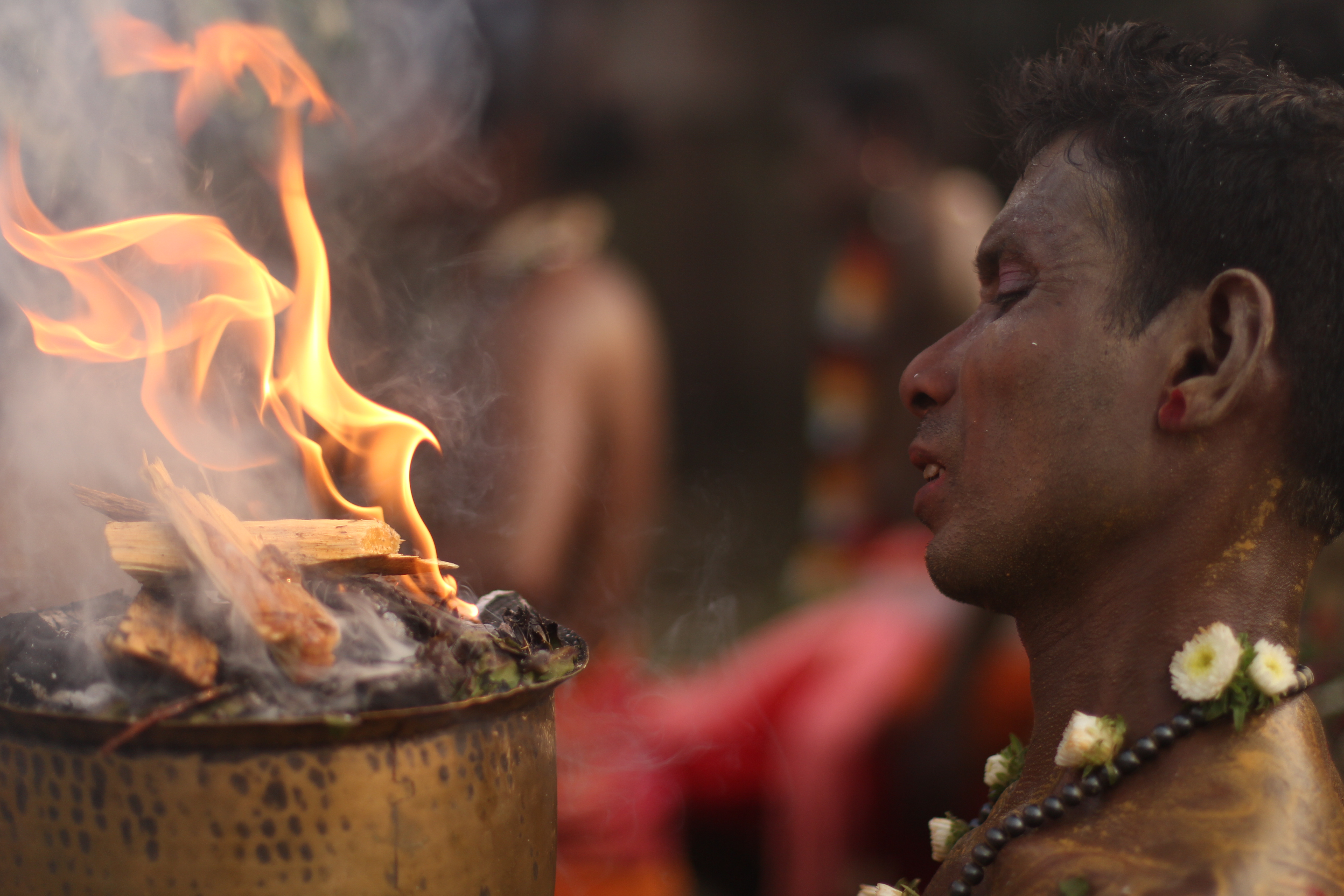When the Lindenmuseum Stuttgart and the Myanmar Institute invited pracritioners and researchers for a conference in Myanmar last October, José-María Arraiza talked about nativism and xenophobia in the country. In this blog post, he recapitualtes his thoughts and analyses.
There is something captivating and addictive about surprises.[i] They perform the magic of bringing you back to your childhood: that time when you still allowed yourself to be haunted by the new and absorbed by fantastic discoveries. A time when the resulting smile is completely free of any pose.
And Myanmar is, above all, surprising.
Last year, I was driving from Yangon to Mawlamyine (Mon State) on a dusty road on a hot afternoon in March. Suddenly, the vans, cars and old trucks on the road stopped. As the sound of distant drums and trumpets came through the window, I told my taxi driver to wait for me. I jumped out with my camera and ran towards a group of bare-chested men followed by an entourage of their fellow villagers.
A group of men and boys walked, played drums and trumpets, and danced in orange longyis. They wore necklaces of flowers and their chests and legs were covered in white ash. Some of them wore bells on their feet or carried long swords. There were individuals whose tongues and cheeks were pierced by thin metal sticks. Others carried buckets with wood and red burning coals. I joined them in their march, not knowing what the festival was about, but after a few years in Myanmar, I was used to just letting myself go with the flow to learn from the mysterious lessons of chance.
[Photograph 2. Hindu festival near Thaton, Mon State (José Arraiza)]
The entourage and the performers crossed the small village road and entered a clearing, where a crowd of people awaited them. A woman put her baby on the floor so that an elderly Sadhu would step over him (without touching the baby). At the end of the road there was a long strip of land filled with burning coals and ashes. The whole village, children first, had congregated to witness the firewalking.
Before the men started to walk one by one on the strip of burning coals, there was an opening ceremony: two men held each end of a large sword, standing side by side. Then, the elderly Sadhu, in a state of trance, placed his bare feet on the swords’ edge while the two men lifted him from the ground half a meter holding each side of the sword. After the guru was put back on the floor, one of the men cut a large watermelon in half with a strike of the sword. Then the fire-walking started. Around twenty men walked on the hot strip of coals, ending their journey in a pond filled with water and mud. I am always filled with astonishment when I recall this experience.
All of this happened during a Hindu village festival. It was not the first time I was drawn into these types of events. I have seen colorful village carnival-like festivals and marionette bull-races near Dawei (Tanintharyi Region), boys dressed up as little Buddha princes mounted on elephants or horses in shinbyu ceremonies, offerings to Kali at night in the Minigone neighbourhood in Yangon, Chinese dragons visiting stores while fireworks flared, full moon blessings… and so many more surprises. Most of the time, I happened to witness such fascinating cultural wealth by accident. My Bamar, Karen or other colleagues seemed unable to have imagined how much I, as a foreigner, would be delighted to witness them.
The genuine ethnic citizen and the “mixed blood” other
This ambivalent relation with cultural diversity always struck me. The Hindu festival I described would probably be seen as something foreign by many Burmese. While Buddhists and persons of all ethnicities normally witness and enjoy each other´s community festivals throughout Myanmar, many would unfortunately also refer to the amazing people participating in the Hindu festival with derogative words such as “kala” or “mixed blood” (thwe-hnaw), implying a foreigner status of the participants.[ii] Why? Because of their descent from colonial workers who arrived in the 19thCentury or later.
This tendency to look down on persons of Indian descent is well entrenched in Burmese society. Indeed, it is part of Myanmar’s institutional and legal framework, with the 1982 Citizenship Law as the most egregious example. The law gives full citizen status primarily to the Taingyintha, that is, the members of the eight recognized “national races” (Bamar, Chin, Kachin, Karen, Kayah, Mon, Rakhine and Shan), which was officially divided further into 135 sub-groups. All others (including persons of South Asian origin) are – with exceptions – “naturalized” or “associated” (in practice, second class) citizens, if not technically stateless, as are most Rohingya in Rakhine State. In that way, Non-Taingyintha are unapologetically understood to be outsiders, not even legitimate citizens.
This phenomenon is by no means a Burmese invention. This intense animosity towards internal minorities considered to be foreign due to their perceived foreign connections was surgically analyzed by Joseph Higham in his book “Strangers in the Land: Patterns of American Nativism”.[iii] While Higham focused on the diverse waves of migration that contributed to the American “melting pot”, his concept applies to some extent to the situation of minorities of South Asian descent in Myanmar.
Is there an Alternative to Nativism?
The origins of nativism as a political undertaking in Burma date back to at least the 1930s when Bamar Buddhist nationalism saw the large community of Indian colonial workers of Yangon as one of the causes of their anti-colonial movement. In the eyes of early Burmese nationalists, the emerging nation was threatened by the influx of persons of Indian origin. This trend fueled the Indo–Burmese riots of July 1938, which led to thousands of persons returning to India. Then, in the early 1960s as part of the “Burmanisation” policy of General Ne Win, property confiscations and other hardships led again to the practical expulsion of thousands of Indians and other minorities from Burma.
This particular history of violence and persecution against minorities continued with the inter-communal riots in Rakhine State and other parts of Myanmar since the early 2000s. This occurred in parallel with the emergence of an aggressive form of Buddhist nationalism which materialized in the 969 movement, a nationalist movement opposed to what they saw as the expansion of Islam in Myanmar. This ultranationalist group led to the creation of Ma Ba Tha (Association for the Protection of Race and Religion), which was later rebranded as the Buddha Dhamma Parahita Foundation, after the former was disavowed by the Maha Sangha Nayaka Committee in 2017[iv]. However, also the rebrand was banned by the Committee in late 2019.[v]
When will it end?
The question is, will this seemingly mainstream xenophobia survive long? The great difficulties facing the first government of the National League for Democracy to address the overarching power of the military, end ethnic conflicts and solve the situation in Rakhine State does not provide much cause for optimism. Indeed, all these conflicts have escalated. The fact that Aung San Suu Kyi’s popularity grew significantly after her appearance in the International Court of Justice defending Myanmar (including its military authorities) from the accusation of genocide speaks volumes about the nation’s complex power relations and maladies.
When I question my Burmese friends and colleagues about these issues, I often get an answer along the lines of “nobody is worried about these things”. There are, however, notable exceptions, especially amongst Karen, Kachin, Shan and other ethnic minorities. However, words like kala or “mixed blood” are part of people’s everyday jargon. I wonder whether this means that racism is normalized? “Yes”, is the answer. Outrageous events such as the detention and incarceration of entire families who try to migrate to Yangon to seek a new life out of the horrors of Rakhine State go barely noticed or even get reframed to fit a normalized discourse in the mainstream Burmese media.[vi]
There are exceptions, of course. Politicians such as Ei Thinzar Maung (Democratic Party for New Society) have spoken out against discrimination and atrocities in Rakhine State. There are NGOs addressing the problems, such as Equality Myanmar or the Smile Foundation. Also, a long list of artists and activists spoke out: movie directors like Steel, cartoonist like Win Aung, writers like Nyi Pu Lay, Myay Hmone Lwin or San San Nweh, for example, are among the exceptional voices of dissent.
It is an uphill battle, though. As U Myo Win, Executive Director of the Smile Foundation, tells me, “the people who are fighting discrimination now will only be recognized after the paradigm shifts. Currently, there is a fear to speak out against mainstream xenophobia. Despite the fact that the media is no longer as censored as it was before, many people still fear repercussions if they step out of line.”
I ponder whether the hope for an alternative to nativism, racism and xenophobia lies in the younger generation. It probably does but will need some help if it is to promote lasting positive change. My former colleague Marlar, a civil society practitioner, is hopeful: “The younger generations are more exposed to diversity, we tend to make friends easily and accept the different communities”.[vii] I share this optimism, and I long to return to Myanmar as soon as the global pandemic allows it again. Local peace activists using Buddhist ideas of non-violence and ethics shared across ethnic and religious divides do bring hope even if they are not the decision makers.[viii] I am afraid, though, that the burning coals of xenophobia will outlast those of the coronavirus.
[i] This text is based on the presentation “Is there an Alternative to Nativism? Exploring the Alternatives to Mainstream Xenophobia and Discrimination Against Minorities in Contemporary Myanmar”, by the author and Phyu Zin Aye in the context of the conference “Minorities in Myanmar”, Linden Museum Stuttgart, 5–7 October 2020.
[ii] Michal Lubina, “Overshadowed by Kala. Indian-Burma Relations”, 40 Politeja,
Modern South Asia: a Space of Intercultural Dialogue (2016), 435-454
[iii] John Higham, Strangers in the Land, Patterns of American Nativism (1860–1925) (Rutgers University Press 1983).
[iv] “Buddhism and State Power in Myanmar”, International Crisis Group (2017), available at https://www.crisisgroup.org/asia/south-east-asia/myanmar/290-buddhism-and-state-power-myanmar
[v] Mathew J. Walton and Ma Khin Mar Mar Kyi, “Is this the End of Ma Ba Tha?,” Tea Circle, A Forum for New Perspectives on Burma/Myanmar, https://teacircleoxford.com/2019/12/02/is-this-the-end-of-ma-ba-tha/
[vi] “Five-year-old boy among 30 Rohingya arrested for travelling in Myanmar”, The Guardian, 8 October 2019, available at https://www.theguardian.com/global-development/2019/oct/10/five-year-old-boy-among-30-rohingya-arrested-for-travelling-in-myanmar
[vii] Some names have been changed to ensure the protection of personal data.
[viii] Camilla Orjuela (2020) Countering Buddhist radicalisation: emerging peace movements in Myanmar and Sri Lanka, Third World Quarterly, 41:1, 133-150.

José-María Arraiza (PhD, Åbo Akademi University) worked for the last five years implementing projects providing access to legal identity (civil documentation) and Housing, Land and Property rights for vulnerable minorities.

This is a great article and analysis of nativism and ethnic relations in Myanmar. One hopes that the next generation will be able to address them and help to build a more inclusive society.
This is a great article and analysis of nativism and ethnic relations in Myanmar. One hopes that the next generation will be able to address them and help to build a more inclusive society.